In today's interconnected business landscape, selecting the right communication tool is a strategic decision that impacts productivity, client relationships, and operational efficiency. The market for video call apps has evolved far beyond simple face-to-face conversations. Modern platforms now serve as the central hub for unified communications (UC), integrating telephony, messaging, and advanced collaboration features.
For businesses in the AE region and beyond, choosing an application requires a deep dive into security protocols, integration capabilities with existing CRM and ERP systems, and the flexibility to support various deployment models. This is particularly crucial for organisations in regulated sectors like finance and healthcare, where compliance and data security are paramount. This guide provides a comprehensive analysis of the top video call apps and resources for 2025, helping you navigate the complexities and select a solution that aligns perfectly with your enterprise needs.
We will examine each platform's strengths, limitations, and specific use cases relevant to enterprise telephony and scalable contact centre operations. When evaluating various video call apps, consider their integrated recording functionalities. For tips on maximising this feature, explore relevant resources on topics like the best practices for recording videos.
This resource is designed to be a definitive guide, offering a clear, professional comparison to inform your decision-making process. Each entry includes detailed analysis, screenshots, and direct links to help you find the best fit for your team, whether you are an SME looking to scale or a large enterprise seeking a secure, flexible UC solution. We will delve into everything from AI-powered VoIP services to comprehensive platform directories, ensuring you have the information needed to make a well-informed choice.
1. Zoom Phone — Cloud VoIP Services powered by AI
Zoom Phone stands out as a premier choice for businesses seeking to consolidate their communication stack. It masterfully integrates video, chat, and voice into a single, cohesive platform, eliminating the friction of switching between disparate applications. This unified approach is not just about convenience; it is a strategic move that enhances productivity by centralising all communication channels within the familiar and user-friendly Zoom interface.
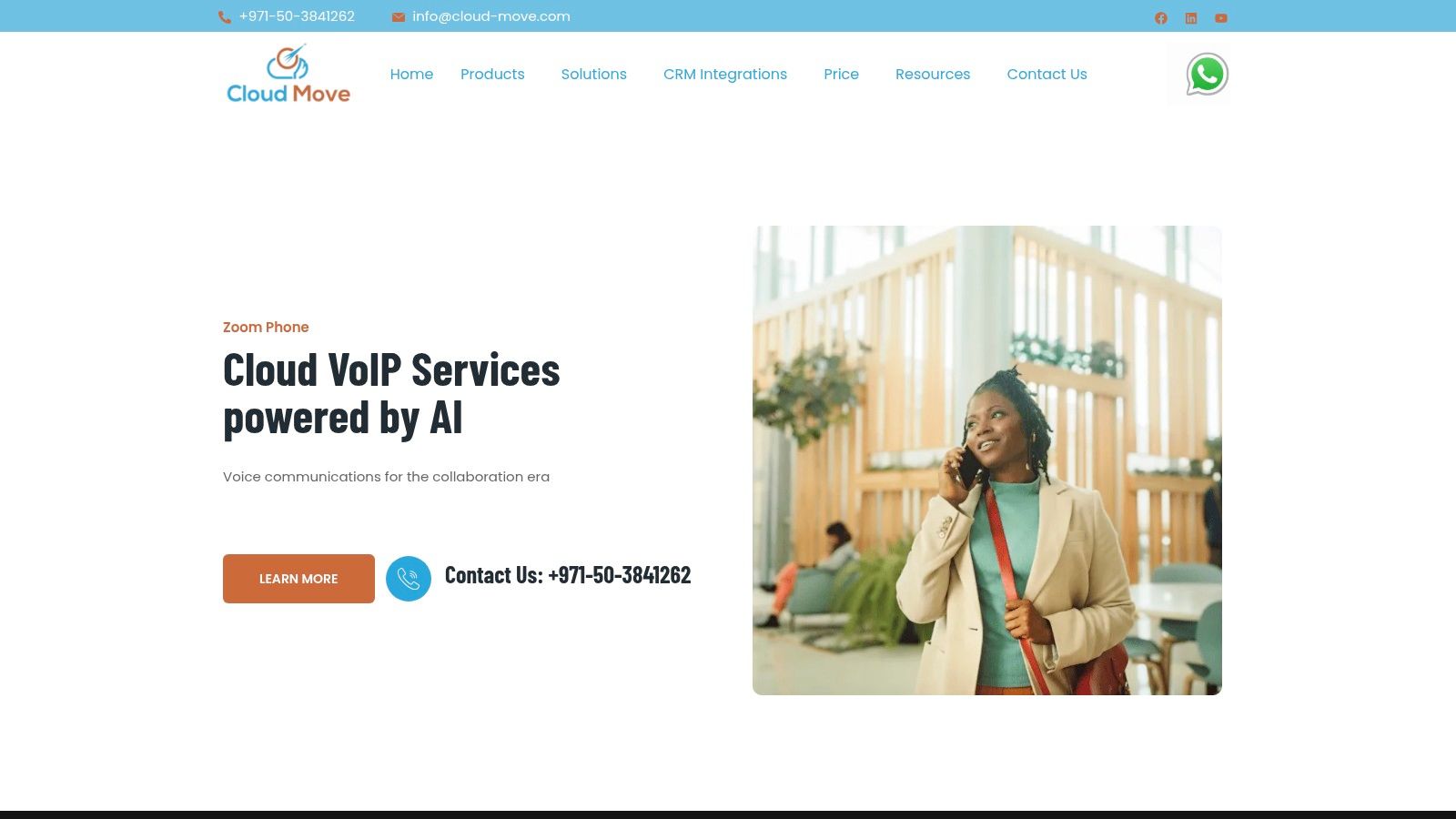
The platform's true power lies in its AI-driven features, which transform standard telephony into an intelligent business tool. Capabilities like automated call transcription, real-time sentiment analysis, and smart call routing allow teams to focus on high-value interactions rather than manual tasks. For contact centres and sales teams, these features provide actionable insights and significantly improve customer engagement and operational efficiency.
Beyond video, many modern platforms offer integrated voice over IP (VoIP) and texting functionalities, crucial for a comprehensive communication strategy. For a broader look at providers offering these services, consider checking out this guide to the 12 Best VoIP with Texting Providers for SMBs in 2025.
Key Strengths and Use Cases
One of the most significant advantages of Zoom Phone is its deployment flexibility. Organisations can choose a full cloud, on-premise, or a hybrid model, ensuring a perfect fit for their specific security, compliance, and infrastructure requirements. This adaptability makes it a viable solution for industries ranging from healthcare to finance.
For a detailed exploration of its capabilities, you can learn more about Zoom Phone and its cloud VoIP services.
Practical Implementation:
- Unified Customer View: Deep CRM integrations with platforms like Salesforce and Microsoft Dynamics 365 provide agents with a complete customer history directly within the calling interface, enabling more personalised and effective support.
- Global Voice Quality: Leveraging partnerships with Microsoft Azure and top local telecom providers such as Etisalat and DU, Zoom Phone delivers exceptional call clarity and reliability, which is critical for international business operations.
- Scalability: The platform scales effortlessly from small teams to large enterprises, allowing businesses to expand their communication infrastructure as they grow without needing to switch providers.
Website: https://cloud-call-center.ae/zoom-phone/
2. Zoom
Zoom has established itself as a cornerstone in the world of video call apps, evolving from a simple meeting tool to the comprehensive Zoom Workplace platform. Its primary strength lies in its frictionless user experience; joining a meeting is famously straightforward, often requiring no downloads for guests who can access calls directly from a web browser. This ease of use has made it a default choice for countless organisations, ensuring that even non-technical stakeholders can connect without hassle.
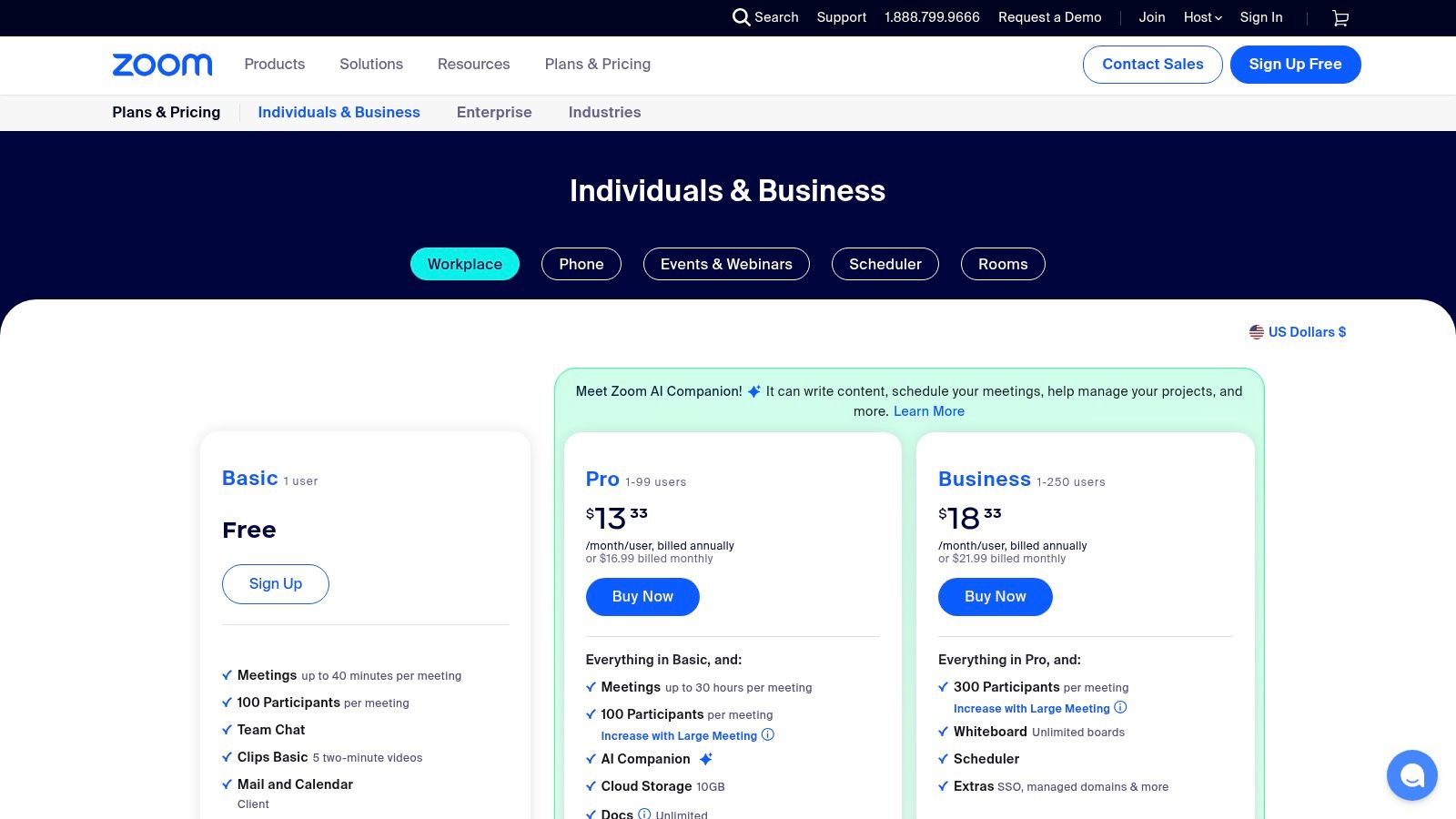
For businesses, Zoom provides a scalable and robust ecosystem. The platform supports high-definition video and audio, alongside essential collaboration features like screen sharing, virtual backgrounds, and breakout rooms, which are invaluable for training and workshops. The introduction of the AI Companion adds intelligent features like meeting summaries and next-step generation, enhancing productivity without an additional cost on paid plans.
Key Features and Implementation
Zoom’s tiered structure is designed to support businesses as they grow. While the free plan is suitable for personal use, its 40-minute group meeting limit makes it impractical for professional settings.
- Pro Plan: Ideal for small teams, removing the time limit and adding cloud recording capabilities.
- Business/Enterprise Tiers: These unlock critical administrative features, including single sign-on (SSO), managed domains, company branding, and enhanced compliance options. This is where Zoom becomes a true enterprise-grade solution, allowing for centralised management and security oversight.
- Add-ons: The platform's modularity allows organisations to add services like Zoom Phone for a complete UCaaS solution, or Zoom Webinars for large-scale virtual events.
Implementation is generally straightforward, but larger deployments benefit from careful planning around user provisioning, especially when integrating with SSO providers like Okta or Azure AD. Its extensive list of hardware certifications ensures compatibility with a wide range of conference room equipment.
Website: https://www.zoom.us/pricing
3. Microsoft Teams
Microsoft Teams has become the central collaboration hub for organisations invested in the Microsoft 365 ecosystem. More than just one of the leading video call apps, it integrates persistent chat, file sharing, and powerful video meetings into a single, unified interface. Its key differentiator is its deep, native integration with other Microsoft services like Outlook, SharePoint, and OneDrive, creating a seamless workflow that removes the friction between different productivity tools. This makes it an almost default choice for businesses already utilising Microsoft’s suite.

For businesses, Teams offers an enterprise-grade solution backed by Microsoft's robust security and compliance framework. Features such as meeting lobbies, live captions, breakout rooms, and comprehensive recording options are standard. The platform's true strength is revealed in its administrative controls, which allow for granular governance over user permissions, data retention policies, and external access, a critical requirement for regulated industries.
Key Features and Implementation
Microsoft Teams is typically bundled with Microsoft 365 subscriptions, making its pricing complex but often cost-effective for existing customers. While a capable free version exists, professional use demands a paid plan.
- Microsoft 365 Business Tiers: These plans are the most common entry point, bundling Teams with familiar Office apps and cloud services. They remove meeting time limits and expand participant caps.
- Enterprise Plans (E3/E5): Aimed at larger organisations, these plans unlock advanced security, compliance, and analytics features. The E5 licence notably includes the Teams Phone Standard licence for PSTN calling capabilities.
- Teams Phone Add-on: For organisations needing a full cloud telephony solution, the Teams Phone add-on transforms the platform into a complete UCaaS system, replacing traditional PBX hardware.
Implementation is straightforward for basic use but requires careful planning for enterprise-level deployments, especially when configuring PSTN connectivity and governance policies. Understanding the licensing structure is key to optimising costs, and you can learn more about the specifics of Microsoft Teams deployment.
Website: https://www.microsoft.com/microsoft-teams
4. Google Meet
Google Meet has become a dominant force in the video call apps space, primarily due to its seamless integration within the Google Workspace ecosystem. Its core strength lies in its browser-based accessibility; participants can join meetings directly with a link, eliminating the need for mandatory software installations. This frictionless entry point makes it an incredibly convenient option for organisations that heavily rely on Gmail and Google Calendar for their daily operations.
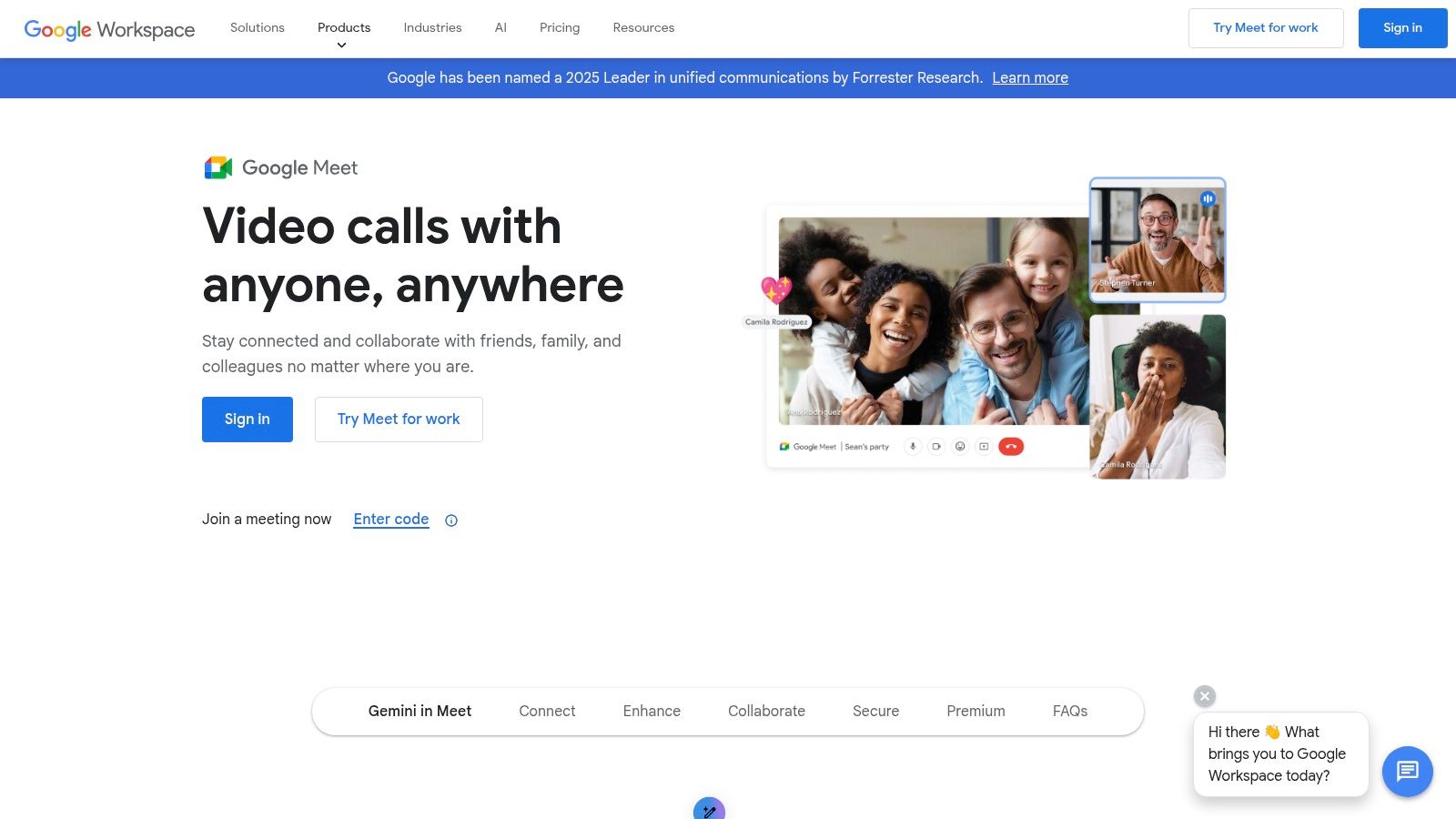
For businesses already invested in Google's suite of tools, Meet offers unparalleled scheduling and user management. The platform leverages Google's robust infrastructure to deliver stable, high-quality video and audio, supported by intelligent features like AI-powered noise cancellation and live captions. As one of the leading video teleconferencing solutions, its intuitive interface ensures that users can connect and collaborate with minimal training, keeping the focus on productivity rather than platform management.
Key Features and Implementation
Google Meet's functionality is directly tied to Google Workspace subscription tiers, scaling from basic individual use to enterprise-level requirements. The free version offers generous 60-minute meetings, but professional features are reserved for paid plans.
- Workspace Individual/Business Starter: These plans remove the time limit and introduce features like meeting recordings saved to Google Drive, making them suitable for freelancers and small teams.
- Business Standard/Plus & Enterprise Tiers: Unlocks advanced capabilities crucial for larger organisations, such as increased participant capacity (up to 1,000), attendance tracking, breakout rooms, and enhanced security controls like single sign-on (SSO) and data loss prevention (DLP).
- AI Integration: Higher-tier plans benefit from AI features like automated meeting transcripts and summaries, which significantly improve post-meeting workflows.
Implementation is straightforward for existing Workspace customers, as user provisioning is handled through the Google Admin console. The deep integration with Calendar simplifies scheduling, while its compatibility with Google Meet hardware makes it easy to equip conference rooms for a consistent hybrid work experience.
Website: https://workspace.google.com/products/meet/
5. Webex by Cisco
Webex by Cisco has a long-standing reputation as a secure and reliable enterprise-grade communication platform. Rooted in strong security principles, it offers a comprehensive suite that goes beyond simple video calls to include messaging, calling, and sophisticated event management tools. Its primary appeal is to organisations that prioritise security and require a robust, all-in-one solution that can scale from small teams to large, globally distributed enterprises.
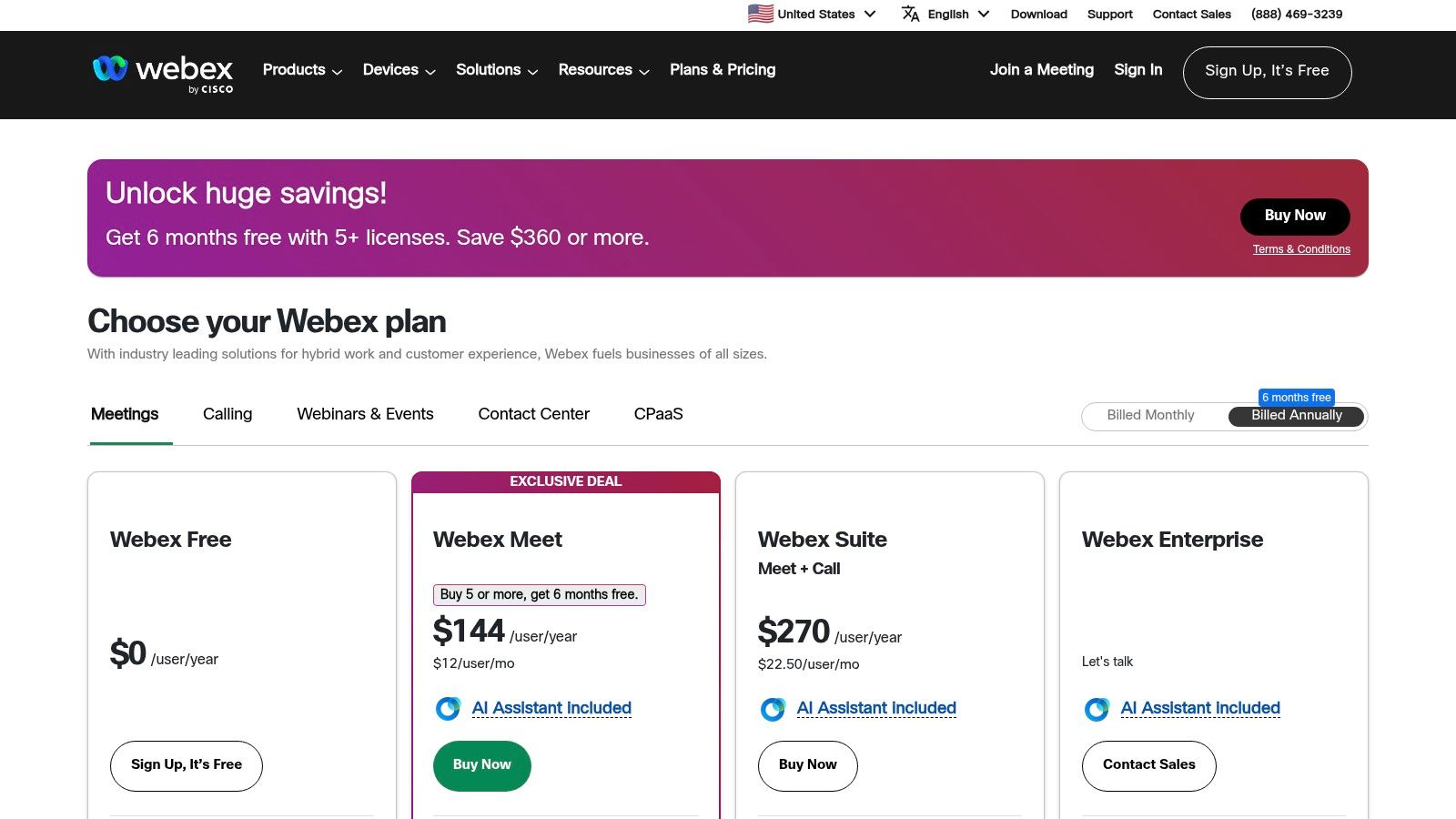
For businesses operating in regulated industries, Webex provides peace of mind with end-to-end encryption options and advanced compliance features. While its interface can feel more complex than some competitors, this is often a trade-off for its depth of functionality and administrative control. Features like AI-powered noise removal and real-time translation demonstrate its commitment to improving the core meeting experience, making it a powerful choice among professional video call apps.
Key Features and Implementation
Webex offers a tiered pricing model, including a functional free plan suitable for individuals or small-scale use, which provides meetings up to 40 minutes for 100 attendees.
- Meet Plan: This entry-level paid tier removes the time limit, extends cloud recording storage, and introduces live polling and Q&A features, making it suitable for professional teams.
- Webex Suite (Business/Enterprise): Unlocks the full power of the platform, bundling meetings, calling, and messaging. Enterprise tiers add critical security features like mandatory single sign-on (SSO), advanced diagnostics, and compliance tools such as FedRAMP authorisation.
- Add-ons: The ecosystem is enhanced with powerful tools for Webex Events and Webinars, which are among the most mature in the market, offering detailed management for large-scale virtual gatherings.
Implementation in a corporate environment often involves integration with Cisco hardware and other enterprise systems. Careful planning is needed for network configuration and user provisioning, especially for organisations deploying the full suite with PSTN calling capabilities.
Website: https://www.webex.com/pricing
6. GoChat Messenger by etisalat by e&
GoChat Messenger emerges from the UAE as a unique super-app, integrating high-definition video and voice calls with a suite of localised services. Developed by etisalat by e&, its primary differentiator is its deep integration into the regional ecosystem, offering a communication tool optimised for users within the UAE. Unlike global competitors, GoChat bundles its free video call app capabilities with practical daily-life features, creating a convenient, all-in-one platform for residents.
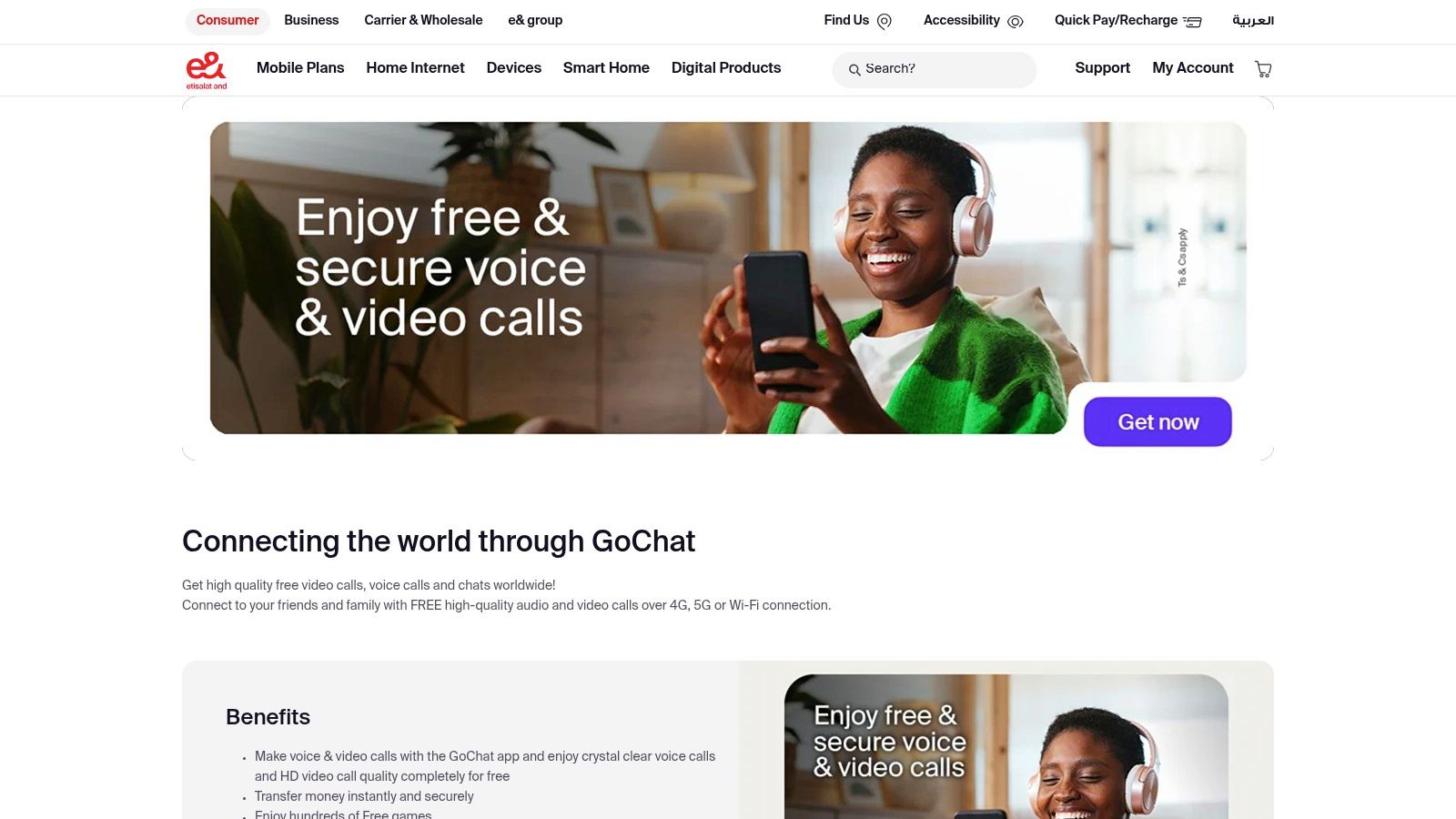
For businesses operating primarily in the region, GoChat presents an interesting proposition for local customer engagement and internal communication. While it lacks the enterprise-grade administrative controls of platforms like Zoom or Teams, its value lies in its accessibility. The service works over any Wi-Fi, 4G, or 5G network and does not require users to have an etisalat contract, broadening its reach. This makes it a practical tool for quick, informal connections where a full-scale meeting platform might be excessive.
Key Features and Implementation
GoChat's model is less about tiered business plans and more about an integrated consumer experience that can be leveraged for specific business interactions. Its core offering is free, focusing on adding value through its integrated services.
- Free Voice and Video Calls: Provides unlimited, clear HD calls over any data connection, making it a cost-effective communication channel.
- Integrated Local Services: The platform incorporates features like an eWallet, bill payments, local offers, and rewards. This transforms it from a simple video call app into a lifestyle utility, increasing user stickiness.
- Regional Optimisation: Being developed by a major local telecom provider ensures the application is optimised for network conditions within the UAE, potentially offering more stable connections.
Implementation is as simple as downloading a mobile application. The main consideration for businesses is not technical deployment but strategic use: it is best suited for B2C interactions with a UAE-based audience, customer support for local clients, or informal team check-ins rather than structured corporate meetings.
Website: https://www.etisalat.ae/en/c/promotions/gochat-messenger/plan.html
7. BOTIM
BOTIM has carved out a significant niche as a communication super-app, particularly within the Middle East and specifically the UAE. While it offers the high-definition video and voice calls expected from modern video call apps, its true distinction lies in its integration of financial services and local connectivity solutions. It is designed to be a central hub for daily communication and transactions, making it an indispensable tool for its large regional user base.
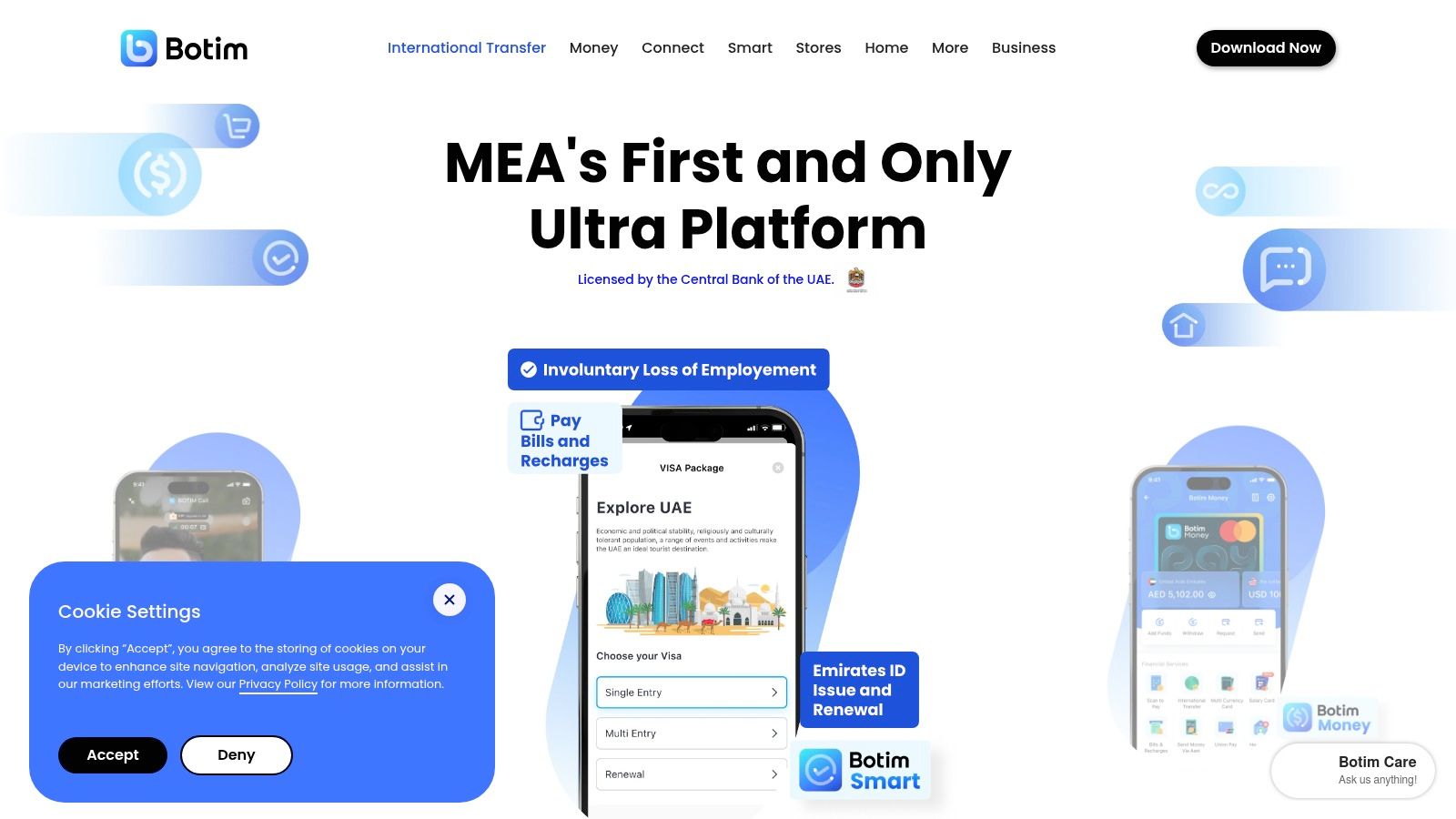
For businesses operating in or engaging with the UAE market, understanding BOTIM is crucial. It’s not just a meeting platform but a multi-faceted application that reflects regional digital habits. While its feature set includes standard group calls and chats, the platform’s value is amplified by its built-in digital wallet and payment transfer capabilities. This unique combination positions it differently from pure-play communication tools, offering a glimpse into the future of integrated digital lifestyle platforms.
Key Features and Implementation
BOTIM’s model is centred on accessibility and multi-functionality, with features often tailored to regional regulatory and consumer needs. It operates on a freemium model, though certain advanced communication features may require subscriptions depending on local telecommunication policies.
- Core Communication: Provides free, end-to-end encrypted HD video and voice calls, group chats, and file sharing across mobile and desktop platforms. This makes it a reliable choice for everyday personal and professional conversations.
- Integrated Payments: The embedded BOTIM Pay wallet allows users to send money internationally, pay bills, and top up mobile credit directly within the app, streamlining financial tasks.
- Localised Services: The platform often includes features and promotions specifically organised for the UAE market, reinforcing its strong regional focus.
Implementation for users is as simple as downloading the app from the relevant store. For businesses, its primary value is as a common communication channel for engaging with clients and partners in the region, rather than as an internal, enterprise-grade unified communications system. Its feature overload may deter users seeking a simple calling tool, but for those embedded in its target market, it provides unparalleled convenience.
Website: https://botim.me/
8. Apple App Store – Messaging & Video Apps
While not a standalone video call application, Apple’s App Store serves as a critical, curated gateway for discovering and deploying communication tools within the Apple ecosystem. Its dedicated stories, like the one for messaging and video apps, simplify the discovery process for iPhone, iPad, and Mac users, offering a centralised and trusted repository. For businesses operating primarily on Apple hardware, the App Store ensures a baseline of security and privacy, as all listed applications undergo a stringent review process.
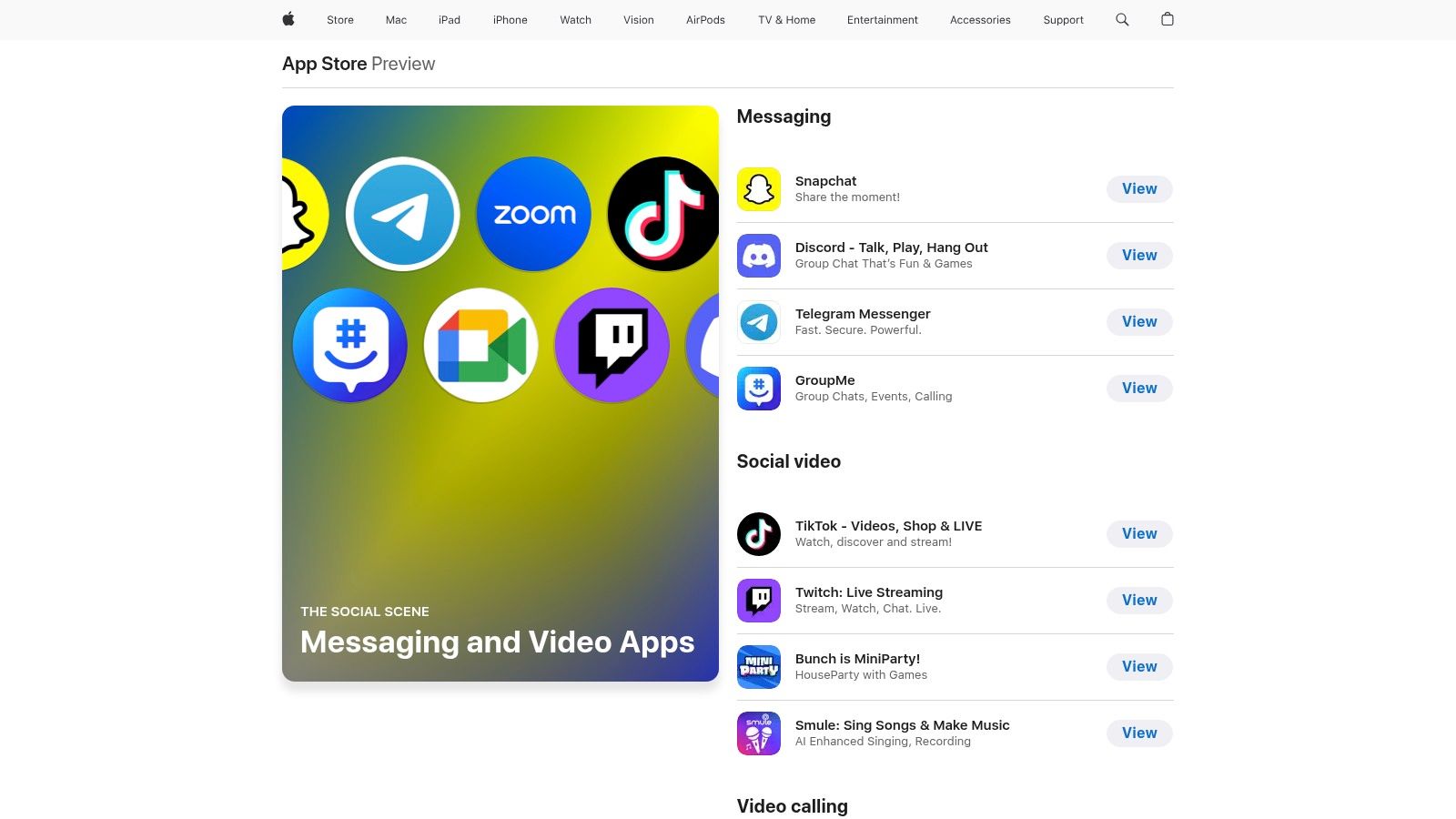
This platform excels in providing a frictionless user experience, from one-tap installations to seamless updates and centralised subscription management. The editorial curation helps organisations identify reputable and high-quality video call apps that are optimised for their devices. For regional operations, such as those in the UAE, the App Store offers localised billing and content, simplifying procurement and management for distributed teams.
Key Features and Implementation
The primary value of the App Store is in its role as a secure distribution and management platform rather than as a direct communication service. It streamlines the deployment of third-party video call solutions for IT administrators.
- Trusted Distribution: Each app is vetted through Apple's review process, which checks for security vulnerabilities, privacy policy adherence, and performance standards. This reduces the risk of deploying insecure software on corporate devices.
- Centralised Management: Through Apple Business Manager, organisations can purchase app licences in volume and deploy them remotely to company-managed devices, ensuring consistency and control over the software stack.
- User Experience: The seamless integration with Apple ID simplifies authentication and in-app purchases or subscriptions, providing a consistent and user-friendly experience that requires minimal support.
While the platform itself is free to use, the apps within it often follow a freemium or subscription model. The main limitation is its exclusivity; it only serves users within the iOS, iPadOS, and macOS ecosystems, making it a component of a solution rather than a cross-platform strategy on its own.
Website: https://apps.apple.com/us/story/id1576237823
9. Google Play Store
While not a video call application itself, the Google Play Store is the primary and most secure gateway for accessing top-tier video call apps on the Android operating system. It serves as an official, centralised hub where businesses can source and deploy essential communication tools like Zoom, Google Meet, and Microsoft Teams. Its key value lies in its verification process, ensuring that applications are from legitimate developers and have passed Google’s security checks, which is a critical first step for any corporate IT policy.
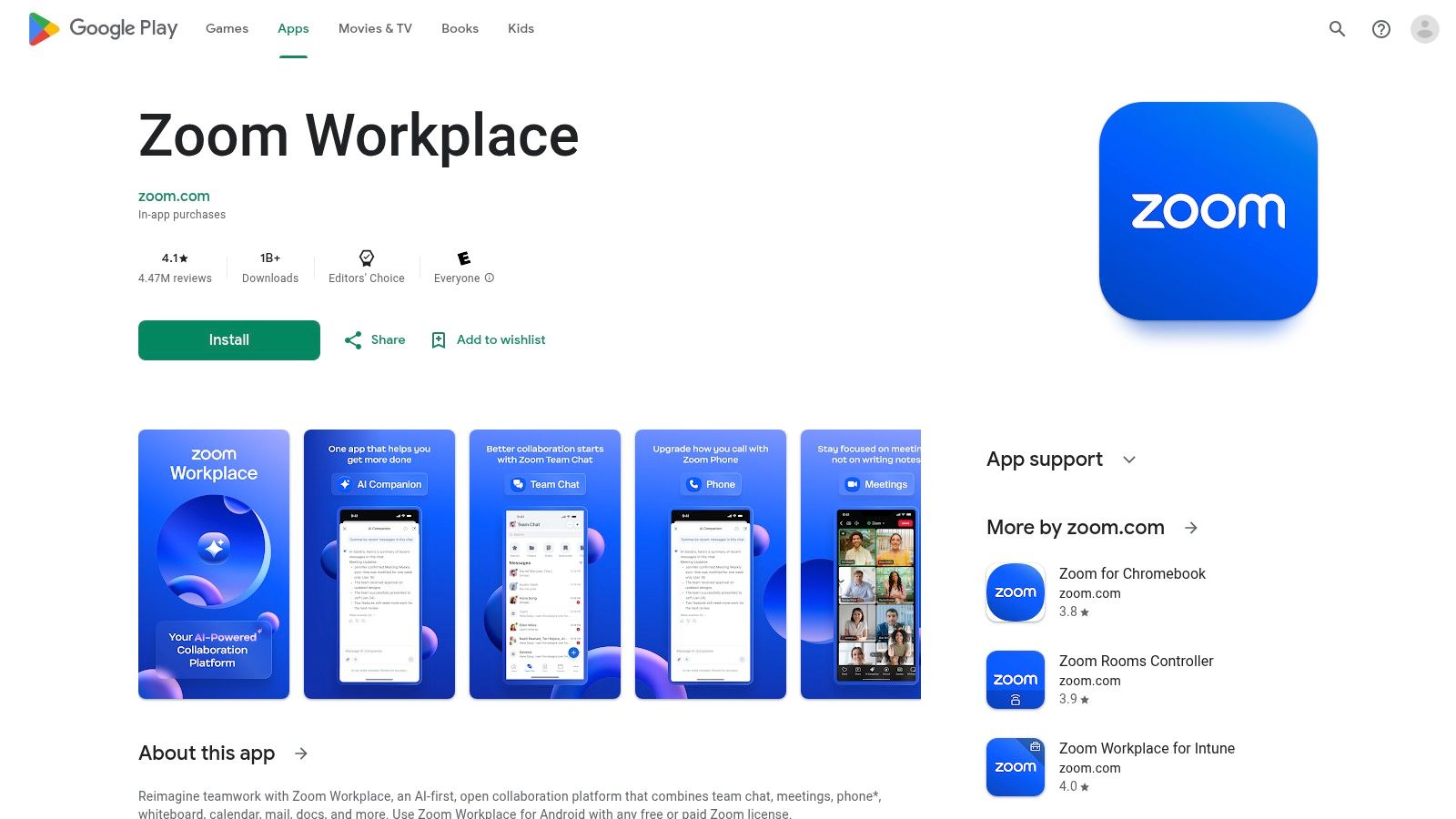
For IT managers, the platform simplifies the management of mobile application deployments. The integrated user review and rating system provides valuable real-world feedback on an app's performance and stability, helping to inform purchasing decisions. Furthermore, its automated update mechanism ensures that security patches and new features are deployed promptly, reducing administrative overhead and maintaining the security of the corporate mobile fleet. The platform’s availability in regions like the UAE ensures access to globally recognised communication solutions.
Key Features and Implementation
The Google Play Store's primary function is distribution and security, acting as the foundation for an organisation's mobile communication strategy. Its features are geared towards safe and efficient app management.
- Verified Developers: All major video calling apps are listed with verified developer profiles, providing assurance against counterfeit or malicious software.
- User Reviews and Ratings: These offer crucial insights into the user experience, highlighting common issues or praised features that may not be apparent in marketing materials.
- Automated Updates: A key security and maintenance feature, this ensures devices are always running the latest, most secure version of a video call app without manual intervention.
- Device Compatibility: The store automatically checks if an application is compatible with a specific device model, preventing installation issues on diverse hardware.
Implementation is straightforward for end-users, but for businesses, it’s often managed through an Enterprise Mobility Management (EMM) or Mobile Device Management (MDM) solution. This allows administrators to control which apps can be installed, push mandatory apps, and manage licences centrally. While the store itself is free, the apps within often have subscription models managed externally. A significant consideration is that its availability is limited on OEM devices without Google Mobile Services.
Website: https://play.google.com/store/apps/details?id=us.zoom.videomeetings
10. G2 – Video Conferencing Category
While not a video call app itself, G2’s Video Conferencing category is an indispensable resource for any organisation evaluating new solutions. It functions as a peer-review aggregator, providing real-world feedback, detailed rankings, and comparison grids that cut through marketing claims. This platform is crucial for the due diligence phase, allowing decision-makers to see how various tools perform in practice for businesses of a similar size and industry.
The primary value of G2 lies in its crowdsourced data. You can filter solutions based on specific features, user satisfaction ratings, and market presence, which helps in shortlisting potential vendors quickly. The platform’s seasonal reports and awards highlight top-performing and emerging tools, offering a current snapshot of the market landscape. For IT managers, the user-reported pros and cons provide unfiltered insights into potential implementation hurdles or standout benefits.
Key Features and Implementation
G2 is best utilised as a research and validation tool before committing to a platform. Its powerful filtering and comparison capabilities help organisations make data-driven decisions.
- Advanced Filtering: Users can narrow down the extensive list of video call apps by specifying company size, desired features (e.g., webinar capabilities, SSO), and pricing models.
- Side-by-Side Comparisons: The platform allows for direct comparisons of up to four products, displaying satisfaction scores, feature lists, and user review highlights in a clear, digestible format.
- User Reviews & Ratings: G2 provides detailed reviews from verified users, often including their role and industry. This offers context and helps assess how a tool might fit within a specific organisational structure.
Access to basic reviews and comparisons is free, though more in-depth reports and certain functionalities may require creating a user account. While vendor incentives can sometimes influence reviews, the sheer volume of feedback generally provides a balanced perspective. It is an essential first stop for creating a shortlist of relevant video conferencing solutions.
Website: https://www.g2.com/categories/video-conferencing
11. Capterra – Video Conferencing Software Shortlist
Rather than being a singular application, Capterra serves as an invaluable resource for discovering and comparing various video call apps. It offers a comprehensive directory where businesses can evaluate potential solutions based on detailed product profiles, verified user reviews, and robust feature checklists. This aggregated approach allows decision-makers to quickly identify a shortlist of candidates that align with their specific operational and budgetary requirements, saving significant research time.
The platform's strength lies in its structured comparison tools. Users can filter options by deployment model (cloud vs. on-premise), business size, key features like webinar capabilities or VoIP integration, and geographic region. The "Shortlist" visualisation provides an at-a-glance view of top-rated tools, mapping them on a chart based on popularity and user ratings, which simplifies the initial discovery phase.
Key Features and Implementation
Capterra is not a tool to be implemented but rather a strategic starting point in the procurement process. It streamlines the evaluation of different video call apps.
- Filtered Directory: Use advanced filters to narrow down the vast market to a manageable list of relevant providers. This helps in focusing only on solutions that meet must-have criteria like specific compliance standards or third-party integrations.
- User Reviews and Ratings: Gain insights from real-world users, which often highlight practical strengths and weaknesses not found in marketing materials. This peer-driven data is crucial for assessing long-term satisfaction.
- Direct Vendor Links: Once a shortlist is created, Capterra provides direct links to official product websites for demos or pricing enquiries. This facilitates a seamless transition from research to direct engagement.
While Capterra is a powerful free resource, users should be mindful that sponsored placements can influence a tool's visibility. It is always advisable to cross-reference pricing information directly with the vendor, as listed details may not always be current.
Website: https://www.capterra.com/video-conferencing-software/shortlist/
12. Signal
Signal has carved out a distinct niche among video call apps by prioritising one core principle above all else: absolute user privacy. For organisations or teams handling highly sensitive information, Signal offers a secure communication channel where end-to-end encryption is the default, not an option. Its open-source Signal Protocol is widely regarded as the gold standard in secure messaging and calling, ensuring that no third party, not even Signal itself, can access the content of your conversations.
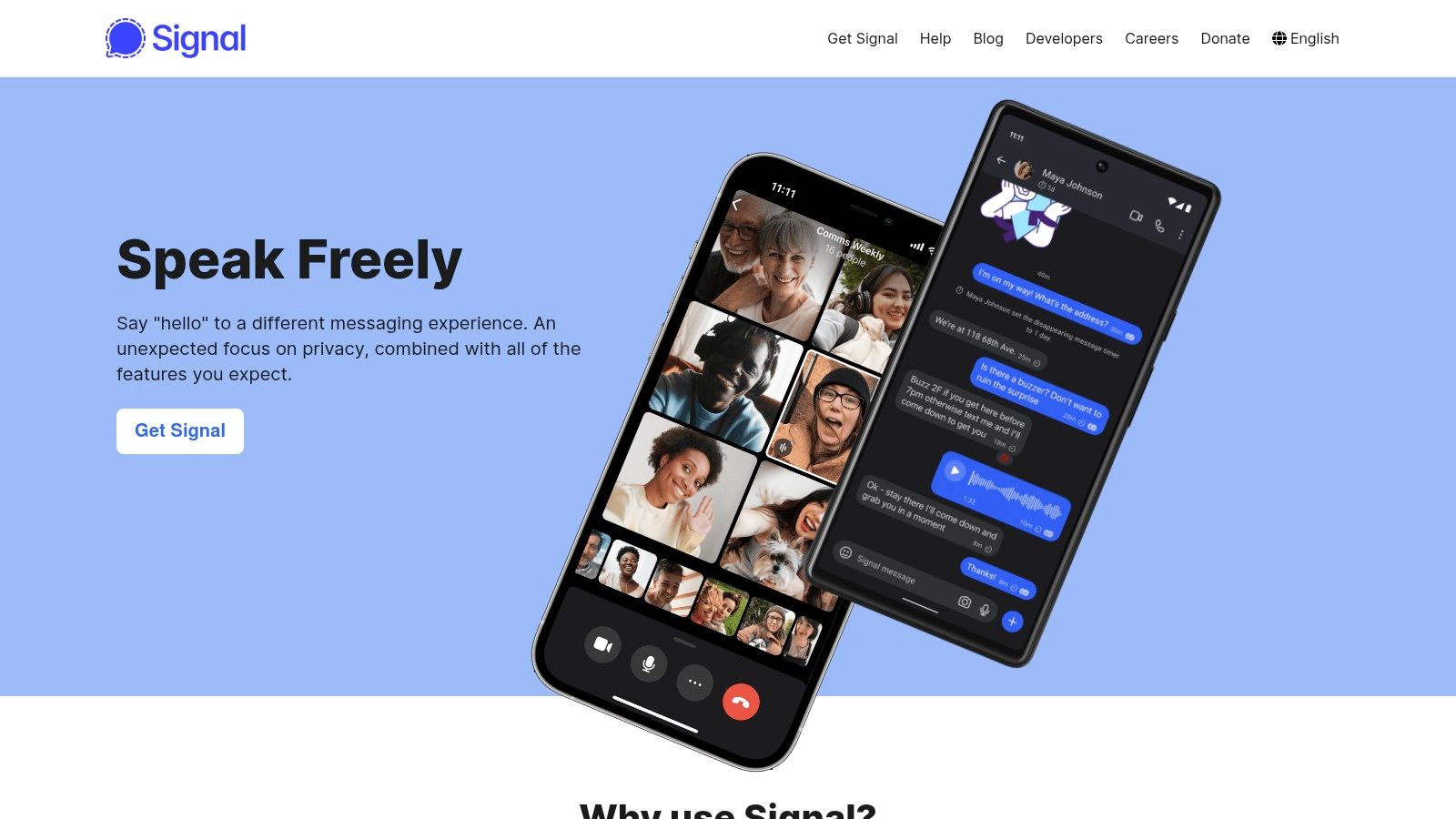
While not built as an enterprise collaboration suite, Signal provides a reliable and completely free platform for one-to-one and small group video calls. The focus is on simplicity and security rather than an extensive feature set. This makes it an excellent supplementary tool for confidential discussions, legal consultations, or internal security team communications where the primary concern is preventing any possibility of eavesdropping or data mining. Its minimalist approach ensures a clean, distraction-free user experience across all major platforms.
Key Features and Implementation
Signal’s value is not in tiered business plans but in its unwavering commitment to security for everyone, free of charge. Implementation is as simple as downloading the app and verifying a phone number.
- Default End-to-End Encryption: All video calls, voice calls, and messages are secured automatically using state-of-the-art encryption.
- Minimal Data Collection: Signal is designed to collect the least possible amount of user data, requiring only a phone number to sign up. It does not store metadata or contact lists.
- Cross-Platform Simplicity: The platform offers a consistent and straightforward interface on iOS, Android, and desktop, making secure communication accessible to all users regardless of their technical expertise.
Because it lacks central administration, user management, and advanced collaboration tools, Signal is not a replacement for comprehensive UCaaS platforms. Instead, it serves a critical role as a secure, secondary channel for conversations that demand the highest level of privacy.
Website: https://signal.org/
Top 12 Video Call Apps Feature Comparison
| Solution | Core Features / Deployment | User Experience & Quality ★★★★☆ | Value & Pricing 💰 | Target Audience 👥 | Unique Selling Points ✨ |
|---|---|---|---|---|---|
| Zoom Phone — Cloud VoIP Services | AI-powered VoIP, Zoom platform integration, cloud/on-prem/hybrid | Crystal-clear voice, AI call handling | Flexible pricing, expert deployment | Small to large enterprises | AI workflows, deep CRM integrations 🏆 |
| Zoom | Video meetings, chat, Zoom Phone add-ons | Ubiquitous join experience, HD quality | Free & tiered plans | Personal & business users | Browser join, wide ecosystem |
| Microsoft Teams | Meetings, Teams Phone, Microsoft 365 integration | Robust security, admin controls | Bundle pricing with Microsoft 365 | Microsoft-centric organizations | Deep MS ecosystem integrations |
| Google Meet | Browser-based, up to 1,000 participants | Smooth scheduling, ease of use | Part of Google Workspace tiers | Individuals & businesses | No install, Google ecosystem integration |
| Webex by Cisco | Meetings, messaging, events, end-to-end encryption | Enterprise-grade security | Free & scalable paid tiers | Enterprises & individual users | Mature webinars, AI noise removal |
| GoChat Messenger by etisalat | Free HD voice/video, eWallet, local services | Optimized for UAE networks | Free with regional offers | UAE residents | UAE network optimization, integrated services |
| BOTIM | HD voice/video, group calls, built-in payments | Multi-platform support | Free app | UAE & MENA region users | Regional licensing, payment services |
| Apple App Store – Messaging Apps | Curated video & messaging apps | Trusted installs, privacy standards | Free download, in-app/subscription based | iOS, iPadOS, macOS users | Regional app store curation |
| Google Play Store | Verified Android apps, compatibility checks | User reviews, safe installs | Free download, subscription/premium options | Android users | Region-aware availability, verified devs |
| G2 – Video Conferencing Category | User reviews, rankings, feature/pricing filters | Crowdsourced satisfaction | Free to use | Buyers evaluating video conferencing tools | Live user feedback, comparison grids |
| Capterra – Video Conferencing Shortlist | Product profiles, ratings, filters | Easy scanning, pros/cons overview | Free to use | Buyers comparing software | Direct vendor links, shortlist visualization |
| Signal | End-to-end encryption, cross-platform calls | Privacy focused, ad-free | Completely free | Privacy-conscious users | Strong encryption, open-source |
Unifying Your Communications for a Competitive Edge
Navigating the expansive landscape of video call apps can feel overwhelming, but as we have explored, the right choice hinges on a strategic alignment with your organisation’s unique operational needs, security protocols, and long-term growth objectives. The journey from evaluating standalone applications like Zoom, Microsoft Teams, and Webex to understanding their potential within a broader unified communications (UC) framework is a critical step for any modern enterprise. The key takeaway is that the most powerful solutions do more than just facilitate face-to-face digital conversations; they act as the central nervous system for your entire communication ecosystem.
For small to mid-size businesses, the decision often balances cost-effectiveness with a rich feature set. Platforms like Google Meet and even regionally focused apps such as GoChat Messenger or BOTIM offer accessible entry points. However, as an organisation scales, the need for robust security, extensive integrations, and sophisticated administrative controls becomes paramount, pushing solutions like Microsoft Teams and Zoom Phone to the forefront. The detailed comparisons and real-world use cases presented in this article are designed to serve as a practical guide, helping you move beyond marketing claims and focus on the functionalities that will genuinely drive productivity and enhance collaboration within your teams.
From Selection to Strategic Implementation
Choosing the best video call app is only the first part of the equation. Successful implementation requires careful planning and a clear understanding of how the new technology will integrate with your existing workflows and business processes. This is where the true value of a unified communications strategy becomes apparent. Instead of managing a disjointed collection of tools for voice, video, and messaging, a consolidated platform provides a seamless experience for both employees and customers, eliminating friction and boosting efficiency.
Consider these critical factors as you finalise your decision and plan for deployment:
- Integration Capabilities: How well does the chosen platform integrate with your core business applications, such as your CRM, project management software, and contact centre solutions? A seamless integration strategy is essential for automating workflows and creating a single source of truth for customer and operational data. For example, integrating Microsoft Teams with your telephony via Direct Routing can centralise all internal and external communication within one familiar interface.
- Security and Compliance: For organisations in regulated sectors like finance or healthcare, security is non-negotiable. Scrutinise the end-to-end encryption standards, data residency options, and compliance certifications (e.g., GDPR, HIPAA) offered by each provider. Platforms like Signal prioritise privacy above all else, while enterprise-grade solutions like Webex by Cisco offer advanced security features tailored for large organisations.
- Scalability and Flexibility: Your chosen solution must be able to grow with your business. Assess the flexibility of pricing tiers and the ease with which you can add or remove users, features, and phone lines. Cloud-based platforms like Zoom Phone are inherently scalable, allowing you to adapt your communication infrastructure to meet changing market demands without significant capital expenditure.
The Future is Unified
Ultimately, the goal is not simply to find a better video conferencing tool but to build a resilient, agile, and interconnected communication foundation that provides a competitive advantage. The leading video call apps are no longer just applications; they are powerful platforms capable of unifying your entire enterprise telephony, transforming your contact centre operations, and elevating your customer experience. By adopting a holistic approach and focusing on strategic integration, you can unlock new levels of collaboration, streamline operations, and prepare your organisation for the future of work.
Choosing and implementing the right unified communications strategy can be a complex undertaking. At Cloud Move, we specialise in deploying tailored solutions using powerful platforms like Zoom Phone and Microsoft Teams to create a seamless, secure, and scalable communication ecosystem for your business. To see how a fully integrated system can revolutionise your operations, book a free, no-obligation demo with our experts today.




